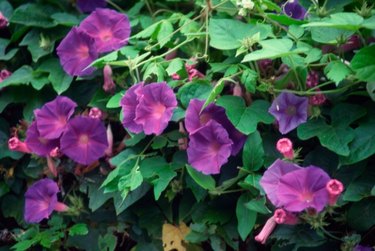
Garden morning glories include the 10- to 15-foot tropical vine Ipomoea tricolor, an old-fashioned garden favorite, and the dwarf, bushy Convolvulus tricolor. The very fast-growing annual vines decorate mailbox posts, scramble over woodpiles and shinny up rough twine trellises to add lasting summer color, camouflage and privacy. Flowers are trumpet-shaped and come in striking colors and patterns. If you want morning glories to come back next year, leave them alone for the winter. They are famous for successfully reseeding themselves. In fact, it takes effort to prevent reseeding.
Growing Morning Glories
Video of the Day
Morning glories grow in poor soils, but do best in fertile soils. They thrive in full sun – and heat -- but will tolerate some light shade. Morning glories don't transfer well, so plant seeds only when soil is thoroughly warm, or start them indoors four to six weeks earlier in peat pots which can be set out for transplanting without any root disturbance. Boost germination by nicking or filing away some of the very hard seed coat with a metal nail file, then soak the seeds at least overnight. Bushy varieties are best for growing in baskets and mixed containers. Vigorous vines will climb whatever they can find, with or without encouragement.
Video of the Day
Morning Glory Reseeding
Mature seed from frost-killed vines will survive even if left outdoors; a good battering by the elements may even help germination. Turn the soil in the spring, when soil is warm, and water it well to get your self-seeded morning glories started. Remove old vines in the spring; compost them if you don't mind an occasional wayward morning glory popping up wherever you spread compost.
How to Prevent Reseeding
If morning glories have gotten out of hand in your yard, or if you want to try new varieties or colors, take action to prevent or slow reseeding in the fall, right after the first frost. Carefully remove all seedpods and dead vines – make sure you don't accidentally scatter any seed – and place them in a garbage bag. Seal it and throw it away. Even active, hot composting may not destroy seeds.
Collecting and Storing Morning Glory Seed
Morning glory seedpods, round and papery, will dry on the vine. Grab the brittle, brown pods while still attached to the vine and crush them, allowing seeds to fall into a small brown paper bag or other wide-mouthed container. According to University of Colorado Extension, seeds will last for at least one year in an envelope keep on an indoor shelf. Greatly increase seed longevity by drying seeds for six hours at a temperature of 100 degrees Fahrenheit – either outdoors on a very hot day, preferably in the shade, or in a warm oven with the door left open. For maximum seed life store dried seeds in paper envelopes inside airtight glass containers or plastic pill bottles and keep storage containers in a refrigerator.
- University of Illinois Extension - Gardener's Corner; Morning Glories Still a Favorite; May 2009
- WSU Extension - Gardening in Western Washington; Morning Glories - Beauty and the Beast; Carolyn Pauw Barden
- Wintersown.org: Seed Saving FAQs - MorningGlory, Ipomea
- The Garden Helper; How to Plant, Grow and Care for Morning Glory Vines; April 1998
- Colorado State University Extension; Storing Vegetable and Flower Seeds; J.E. Ells, et al.; February 2008